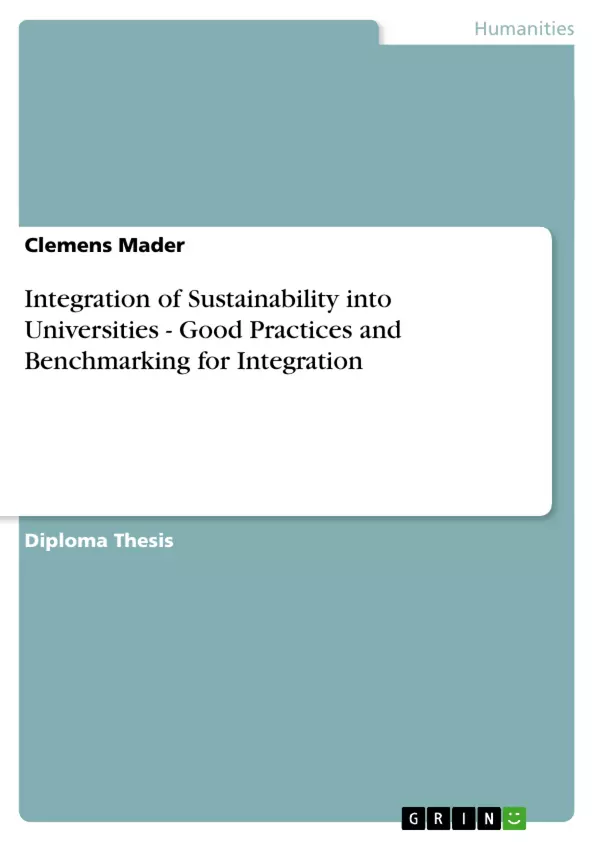The number of charters and declarations, promoting sustainability in education is increasing with the number of universities integrating sustainability. For many universities, those declarations are self commitments and are used to improve public relations. Although they may have further implications, declarations can be a strong policy statement. Over 300 European universities have signed the Copernicus Charta and in the same moment, they sign a commitment for sustainable development. This shows that sustainability became an important issue. Universities can use the Charta to raise awareness among staff and convince them that they should act and demonstrate universities’ role and impact on society. Universities impact society by their four roles.
• Education: Universities train and influence future decision makers
• Research: University research influences daily life
• Administration/Management: Universities are large employers and consume all kinds of resources
• Role in Society/Outreach: Universities have a direct (regional development, actor in society) and indirect (education, research, administration) influence on societal development and especially the surrounding and environment.
By fulfilling their role and obligations, universities can contribute to a sustainable development for the society and the university itself. Good examples of each of those responsibilities offer universities ideas about what they can do. Of course good practices must be adapted to their own structure. To gain insight to the processes and the activities of other “sustainable” universities, universities can participate in the COPERNICUS University Core Group. Within this group, universities can benchmark themselves with others and can get a better understanding about the structure and proceedings of sustainability by learning about good practices and processes of other universities in other countries.
Integrating sustainability offers a new challenge for universities of which they can only succeed – Succeed in social well-being, ecological quality and economic prosperity.
Inhaltsverzeichnis (Table of Contents)
- INTRODUCTION
- MILESTONES, DECLARATIONS AND POLICIES FOR SUSTAINABILITY IN UNIVERSITIES
- The Stockholm Declaration on the Human Environment
- The Taillores Declaration
- Agenda 21
- The Kyoto Declaration
- The CRE-COPERNICUS Charta
- The Global Higher Education for Sustainability Partnership (GHESP)
- The Lüneburg Declaration on Higher Education for Sustainable Development
- The Ubuntu Declaration on Education and Science and Technology for Sustainable Future
- The United Nations Decade of Education for Sustainable Developments (DESD)
- SUSTAINABLE UNIVERSITIES RESPONSIBILITIES
- Education
- Kurt Lewin's Ten Rules for Re-education
- Research
- Administration / Management
- The Sustainability Task Force
- Employment
- Equality and Integration
- Participation and Transparency
- Social Security
- Environmental Concepts
- The Role of Universities in Society
- Universities Contribution to National and Regional Development
- Indirect Role in Society
Zielsetzung und Themenschwerpunkte (Objectives and Key Themes)
This diploma thesis examines the integration of sustainability into universities, analyzing the growing movement towards sustainable practices in higher education. The work explores the role of universities in promoting sustainability through their educational programs, research activities, administrative structures, and societal engagement.
- The evolution of sustainability principles in higher education.
- Key declarations and initiatives aimed at fostering sustainability in universities.
- The various responsibilities of universities in achieving sustainability.
- Good practices and benchmarking methods for integrating sustainability into university operations.
- The significance of the COPERNICUS University Core Group in promoting sustainability collaboration among universities.
Zusammenfassung der Kapitel (Chapter Summaries)
- Introduction: This chapter provides an overview of the diploma thesis's focus on sustainability integration within universities and highlights the growing importance of sustainable development.
- Milestones, Declarations and Policies for Sustainability in Universities: This chapter examines a series of declarations and initiatives, including the Stockholm Declaration, the Taillores Declaration, Agenda 21, the Kyoto Declaration, the CRE-COPERNICUS Charta, the Global Higher Education for Sustainability Partnership (GHESP), the Lüneburg Declaration on Higher Education for Sustainable Development, the Ubuntu Declaration on Education and Science and Technology for Sustainable Future, and the United Nations Decade of Education for Sustainable Developments (DESD). The chapter analyzes the key themes and objectives of these declarations in promoting sustainability in higher education.
- Sustainable Universities Responsibilities: This chapter focuses on the multifaceted responsibilities of universities in advancing sustainability. It examines the roles of universities in education, research, administration/management, and societal engagement. The chapter delves into specific areas of focus, such as the implementation of Kurt Lewin's Ten Rules for Re-education in education, the establishment of a Sustainability Task Force in administration, and the importance of universities' direct and indirect roles in societal development.
Schlüsselwörter (Keywords)
Sustainability, higher education, universities, declarations, policies, good practices, benchmarking, COPERNICUS University Core Group, education, research, administration, management, societal engagement, environmental concepts, social well-being, ecological quality, economic prosperity.
- Quote paper
- Mag. Clemens Mader (Author), 2004, Integration of Sustainability into Universities - Good Practices and Benchmarking for Integration, Munich, GRIN Verlag, https://www.grin.com/document/75222



